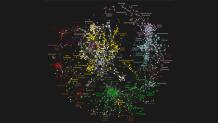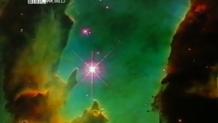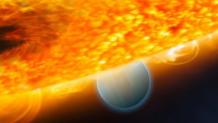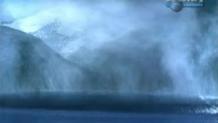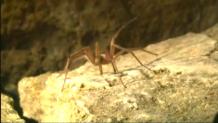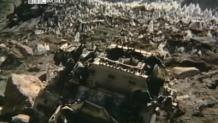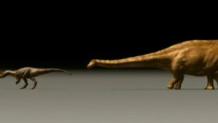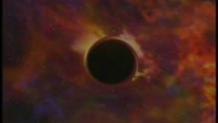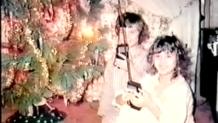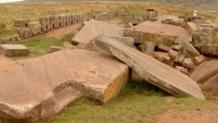
Horizon (1964)
Horizon tells amazing science stories, unravels mysteries and reveals worlds you've never seen before.
User rating:
2000x01 Breath of Life
12 January, 2000 9:00 pm
In this moving film Horizon follows the Loughran family in their fight to save the life of their daughter Sheila who suffers from cystic fibrosis. They lost their youngest daughter Ann to the disease in 1974 at the age of 15, and now as the health of their third daughter Sheila deteriorates, they must face the prospect of losing a second child. The current shortage of donor organs means that Sheila's only hope of survival is a rare and controversial operation that requires her two surviving siblings to undergo an arduous and potentially fatal operation.
An X-ray of Shelia's lungs Cystic fibrosis (CF) is the most common genetic disease in this country and it is incurable. The lungs of people with cystic fibrosis become covered with a sticky mucus making them extremely susceptible to bacterial infection. Over time these infections badly scar the lungs, until eventually they stop functioning. The defective CF gene is harmless when only a single copy of the gene is inherited. However, b
2000x02 The Lost City of Nasca
20 January, 2000 9:00 pm
On a barren desert in South America lies one of the greatest archaeological puzzles in the world. Etched in the surface of the desert pampa sand are hundreds of straight lines, geometric shapes and pictures of animals and birds - and their patterns are only clearly visible from the air. They were built by a people called the Nasca - but why and how they created these wonders of the world has defied explanation.
On the pampa, south of the Nasca Lines, archaeologists have now uncovered the lost city of the line-builders, Cahuachi. It was built nearly two thousand years ago and was mysteriously abandoned 500 years later. New discoveries at Cahuachi are at last beginning to give us insight into the Nasca people and to unravel the mystery of the Nasca Lines.
Distorted heads The Lines were first spotted when commercial airlines began flying across the Peruvian desert in the 1920's. Passengers reported seeing 'primitive landing strips' on the ground below. No one knew who had built them
2000x03 The Diamond Makers
27 January, 2000 9:00 pm
There is something so special about diamonds, and they are so valuable, that people have always been prepared to go to the most extraordinary lengths to find them. But how would we feel about the uniqueness of diamonds if it was possible to make one in a laboratory, just like the real thing, down to the nearest atom? In the last few years there has been a scientific race to do exactly this: to manufacture the perfect gem diamond.
Today the dream is close to becoming reality. Science has finally found a way to replicate in a few days something that nature has taken millions of years to produce - diamonds. These man-made diamonds are so close to the real thing, that they have the same atomic structure as natural diamonds. Even the most sophisticated machines are finding it hard to tell the difference. More importantly, these diamonds can be made and sold at a profit.
Synthetic diamond press: This is the story of the race to produce man-made gem diamonds, from the first faltering st
2000x04 Supervolcanoes
03 February, 2000 9:00 pm
Hidden deep beneath the Earth's surface lie one of the most destructive and yet least-understood natural phenomena in the world - supervolcanoes. Only a handful exist in the world but when one erupts it will be unlike any volcano we have ever witnessed. The explosion will be heard around the world. The sky will darken, black rain will fall, and the Earth will be plunged into the equivalent of a nuclear winter.
Normal volcanoes are formed by a column of magma - molten rock - rising from deep within the Earth, erupting on the surface, and hardening in layers down the sides. This forms the familiar cone shaped mountain we associate with volcanoes. Supervolcanoes, however, begin life when magma rises from the mantle to create a boiling reservoir in the Earth's crust. This chamber increases to an enormous size, building up colossal pressure until it finally erupts.
The last supervolcano to erupt was Toba 74,000 years ago in Sumatra. Ten thousand times bigger than Mt St Helens, it crea
2000x05 Miracle In Orbit
10 February, 2000 9:00 pm
When and how did space and time begin? The birth of the Universe is one of the biggest mysteries in astronomy. It has perplexed the best scientific minds for centuries. Decades before space travel was possible, astronomers dreamed of putting a telescope into orbit to try and answer these fundamental questions. It wasn't until the 1970s, when space flight had become a reality, that NASA resolved to build just such a space telescope. They named it Hubble.
This was one of the most ambitious missions ever conceived. The technical challenges were enormous and it took 12 years to design and build. Travelling at seventeen thousand miles an hour, the Hubble Telescope would take pictures of the furthest reaches of space, transmitting them 400 miles back to Earth.
In April 1990 the Hubble Space Telescope was launched. But just weeks later, disaster struck - the $2 billion telescope had a fatal flaw in its main mirror. This was not just a disaster for NASA; it was a national scandal. Hubble
2000x06 Complete Obsession - Body Dysmorphia
17 February, 2000 9:00 pm
What happens when a completely healthy person wants their leg amputated?
Gregg is 55 and does not feel physically whole. This is despite the fact that he is physically healthy and able-bodied. Gregg believes he is incomplete with two legs and it has been his life-long struggle to get doctors to agree that removing one of his legs is the right thing for him. He isn't delusional. He knows what he is asking for and knows it is strange. But he cannot help his feelings. Gregg suffers from a rare but genuine psychological disorder - a form of body dysmorphia. And Gregg is not alone.
Although Body Dysmorphia is rare, a worldwide network of sufferers is growing and demanding treatment. It affects both men and women and each person has a precise sense of which limb or limbs they want removed.
Cases were cited a hundred years ago but still very little is known about the disorder. No one knows what causes it and very few psychiatrists have even encountered patients with the disorder. All
2000x07 Is GM Safe?
09 March, 2000 9:00 pm
Some people see GM food as a ground-breaking scientific idea that could help to end world hunger and reduce global pollution. Others see it purely as 'Frankenstein foods' on 21st century menus, bringing health and environmental disasters. But what are the real scientific facts behind the newspaper headlines?
Scientists can manipulate the genetic code of life to produce plants with new characteristics never seen in nature. They can isolate any one gene from any organism like an animal or bacterium, and insert it into a completely unrelated species like a plant. The possibilities are almost endless - Scientists can insert a gene from a bacterium into a grape to make it resistant to viruses. Or they can engineer maize that resists drought or potatoes that resist pests, so farmers can use less pesticides on their crops.
For thousands of years we have been tampering with the genes of plants by traditional breeding. But there's a key difference here - with traditional plant breeding gene
2000x08 Planet Hunters
16 March, 2000 9:00 pm
If extra-terrestrials do exist they must have a home. Horizon tells the story of the race to find out where in the Universe this might be. The answer, for scientists across the world, lies in the hunt for planets around distant stars.
Stars which are trillions of miles away from our own solar system.
But the history of the planet hunters is littered with failure. Centuries of searching had thrown up nothing. It was time for the new style planet hunters to step in. However, it is only in the last ten years that these scientists have had the technology to succeed. Even now looking for these distant planets is far from straightforward.
The planets themselves are so faint that they cannot be seen, even by the most powerful telescopes ever built. Instead the astronomers must devise ingenious ways to search for clues to their presence. They examine stars just like our own Sun, across the galaxy, for any give-away characteristics that might indicate that they too have planets circling
2000x09 Constant Craving: The Science of Addiction
30 March, 2000 9:00 pm
2000x10 Moon Children
04 April, 2000 9:00 pm
A handful of children around the world cannot tolerate the sun. Any exposure leads rapidly to skin cancer. They must either play indoors during daylight or be protected from head to toe in UV-proof suits. These children suffer from a strange and rare genetically-inherited disease, xeroderma pigmentosum, or XP, which means that within seconds of the sun's rays touching their skin, they are in danger of developing skin cancer.
Sun Children with XP are missing the crucial gene that repairs damage to DNA and so exposure to any carcinogen - UV light, or even cigarette smoke - is lethal. Unless, they are thoroughly protected they will die from cancer at an early age. There is no cure.
But these tragic children may may lead the way to new and better cancer treatment. Through studying XP sufferers, scientists have reached a whole new understanding of the genetic basis of cancer. They can now predict why one in three people will succumb to cancer. Scientists have discovered how the body sur
2000x11 Mega-Tsunami: Wave of Destruction
12 October, 2000 9:00 pm
Scattered across the world’s oceans are a handful of rare geological time-bombs. Once unleashed they create an extraordinary phenomenon, a gigantic tidal wave, far bigger than any normal tsunami, able to cross oceans and ravage countries on the other side of the world. Only recently have scientists realised the next episode is likely to begin at the Canary Islands, off North Africa, where a wall of water will one day be created which will race across the entire Atlantic ocean at the speed of a jet airliner to devastate the east coast of the United States. America will have been struck by a mega-tsunami.
Back in 1953 two geologists travelled to a remote bay in Alaska looking for oil. They gradually realised that in the past the bay had been struck by huge waves, and wondered what could have possibly caused them. Five years later, they got their answer. In 1958 there was a landslide, in which a towering cliff collapsed into the bay, creating a wave half a kilometre high, higher than a
2000x12 Conjoined Twins
19 October, 2000 9:00 pm
Conjoined twins are among the rarest of human beings. There are probably fewer than a dozen adult pairs living in the world today. Only a few hundred pairs of conjoined twins are born in the whole world each year - they appear about once in every 100,000 births - but more than half of them are stillborn, and one in three live for only a few days.
Of those who survive, a very small number will be selected for separation surgery. But as there are few hospitals with the skills and experience to perform this kind of surgery, separation is still a very unusual event. The harrowing decisions which surgeons have to make when faced with conjoined twins have been highlighted by the recent case in Manchester, England. Separating conjoined twins is not only technically challenging; it can involves life and death decisions about whether one twin should be sacrificed in the hope of saving the other. But "sacrifice surgery" has a poor record of success, and the Manchester case is the latest round
2000x13 The Lost World of Lake Vostok
26 October, 2000 9:00 pm
It sometimes seems as if our planet has no secrets left - but deep beneath the great Antarctic ice sheet scientists have made an astonishing discovery. They’ve found one of the largest lakes in the world. It’s very existence defies belief. Scientists are desperate to get into the lake because its extreme environment may be home to unique flora and fauna, never seen before, and NASA are excited by what it could teach us about extraterrestrial life. But 4 kilometres of ice stand between the lake and the surface, and breaking this seal without contaminating the most pristine body of water on the planet is possibly one of the greatest challenges science faces in the 21st century.
In 1957 the Russians established a remote base in Antarctica - the Vostok station. It soon became a byword for hardship - dependent on an epic annual 1000km tractor journey from the coast for its supplies. The coldest temperature ever found on Earth (-89°C) was recorded here on the 21st July 1983. It’s an unlik
2000x14 Vanished: The Plane that Disappeared
02 November, 2000 9:00 pm
On August 2nd 1947, a British civilian version of the wartime Lancaster bomber took off from Buenos Aires airport on a scheduled flight to Santiago. There were 5 crew and 6 passengers on board the plane - named "Stardust". But Stardust never made it to Santiago. Instead it vanished when it was apparently just a few minutes from touchdown. One final strange Morse code radio message - "STENDEC" - was sent, but after that nothing more was heard from the plane.
Despite a massive search of the Andes mountains no trace of the plane was ever found. For 53 years the families of those who disappeared have not known what happened to their loved ones.
But earlier this year the plane suddenly reappeared on a glacier high up in the Andes, more than 50 km’s from the area where the plane was last reported. In February this year the Argentine army arranged a major expedition to visit the crash site beneath the massive Tupangato peak (6800m). Their aim was to bring back the human remains which ha
2000x15 The Secret Treasures of Zeugma
09 November, 2000 9:00 pm
In the summer of 2000, one of the great frontier cities of the Roman Empire, the city of Zeugma, all but disappeared from the face of the Earth under the flood waters of a dam. In a bid to modernise, the Turkish government has embarked on one of the most ambitious engineering projects in the world, building a series of dams on the Euphrates over the past twenty years. Almost every dam threatens ancient remains that lie below in one of the most archaeologically rich regions of the world. The completion of the Birecik dam, featured in this film, has flooded the valley where Zeugma is buried. The city on the flat plain has entirely disappeared and the waters have now risen to cover 30% of the city on the hillside.
Horizon tells the story of the archaeologists' fifth and final visit, struggling to save what they could before the dam waters rose. It witnesses the uncovering of some of the most beautiful examples of Roman art ever found. The team’s discoveries at Zeugma caused an internat
2000x16 The Valley of Life or Death
16 November, 2000 9:00 pm
At the heart of the AIDS epidemic in Africa, there is a deadly mystery that has puzzled scientists for years. There are groups of people who are four times less likely to get HIV than other people, sometimes living just yards away, across a single valley - people with apparently similar behaviour and lifestyle. Scientists realised that if they could understand why these people are so much less vulnerable to the HIV virus, it might lead to an answer that could save millions of lives. And after 15 years of detective work it turns out there may be a remarkably simple answer: the high risk areas for HIV coincide with tribes who are uncircumcised. In Africa, it seems a man is much more likely to get HIV if he is uncircumcised.
In Kaoma, Western Zambia, a young boy is on his way to the sacred Mukondaa - the tribal circumcision ground. Around him the tribal elders are gathered, dressed in their ceremonial garb, and vivid masks. But the young boy himself is an outsider, not from this tribe,
2000x17 Extreme Dinosaurs
23 November, 2000 9:00 pm
Amazing new discoveries in South America are revolutionising what we thought we knew about the dinosaur world. It now seems that South America was home to both the largest meat-eater - so new it's still without a name - and the largest herbivore - the enormous long-necked Argentinasaurus. And what's more, these dinosaurs lived at the same time in the same place. So it's possible that like in a science fiction movie, in this prehistoric world these two giants of their kind fought each other in a spectacular clash of the Titans.
Horizon follows the scientists to Argentina as they unearth one of these giants - a brand new species of dinosaur; the biggest carnivore ever discovered. Not yet named, this new creature is even bigger than T. rex, the so-called 'king' of the carnivores. The new giant South American predator had a skull bigger than a man that was full of serrated, knife-like teeth and long powerful jaw muscles. They could dissect their prey with almost surgical precision.
B
2000x18 Supermassive Black Holes
30 November, 2000 9:00 pm
In June 2000, astronomers made an extraordinary discovery. One that promises to solve one of the biggest problems in cosmology - how and why galaxies are created. Incredibly, the answer involves the most weird, destructive and terrifying objects in the Universe - supermassive black holes. Scientists are beginning to believe that these forces of pure destruction actually help trigger the birth of galaxies and therefore are at the heart of the creation of stars, planets and all life.
Supermassive black holes are so extraordinary that until recently, many people doubted that they existed at all. The idea of giant black holes the size of the Solar System seemed more like science fiction that reality - such monsters would be so powerful that they could destroy the very fabric of the Universe. But in the last five years a series of discoveries has changed our understanding of supermassive black holes and galaxies forever.
Using the powerful Hubble Space Telescope, scientists have been
2000x19 The Boy who was Turned into a Girl
07 December, 2000 9:00 pm
In 1965 in the Canadian town of Winnipeg, Janet Reimer gave birth to twin boys - Bruce and Brian. Six months later a bungled circumcision left Bruce without a penis. Based on a radical new theory of gender development the decision was taken to raise Bruce as a girl. In 1967 Bruce became Brenda and for the next three decades this case would be at the heart of one of the most controversial theories in the history of science.
The man behind this work was world-renowned psychologist Dr John Money. In the 1950s Dr Money developed a theory that revolutionised our understanding of gender. Money believed that what he called our 'gender identity' - what makes us think, feel and behave as boys or girls - is not fully formed by the time of birth. While we may have some innate sense of being a boy or a girl, for up to two years after birth, our brains are, in effect, malleable and we can be taught to grow up as either a boy or girl by how we are raised - by the toys we are given, the guidance w
2000x20 Atlantis Reborn Again
14 December, 2000 9:00 pm
Horizon puts Graham Hancock's controversial theories about the past to the test, dissecting his evidence for a lost civilisation.
Although scientists believe they have categorically disproved the myth of Atlantis, the idea is more popular now than ever before. The latest exponent of the theory of a single lost source for all civilisation, is Graham Hancock. Although he doesn't call it Atlantis, his compelling ideas about a sophisticated society destroyed in a flood 12,000 years ago seem to be based on a reworking of the original Atlantis myth, whose survivors brought culture, religion, monument-building and civilisation to the rest of the world.
Graham Hancock offers various pieces of evidence to support his theory. He claims that the mysterious lost civilisation left its mark in ancient monuments, which he calculates were built to mirror certain constellations of stars. His hugely popular ideas have attracted such a wide audience that they stand to replace the conventional view
Video Gallery
Coming Soon...
Photo Gallery
Coming Soon...

